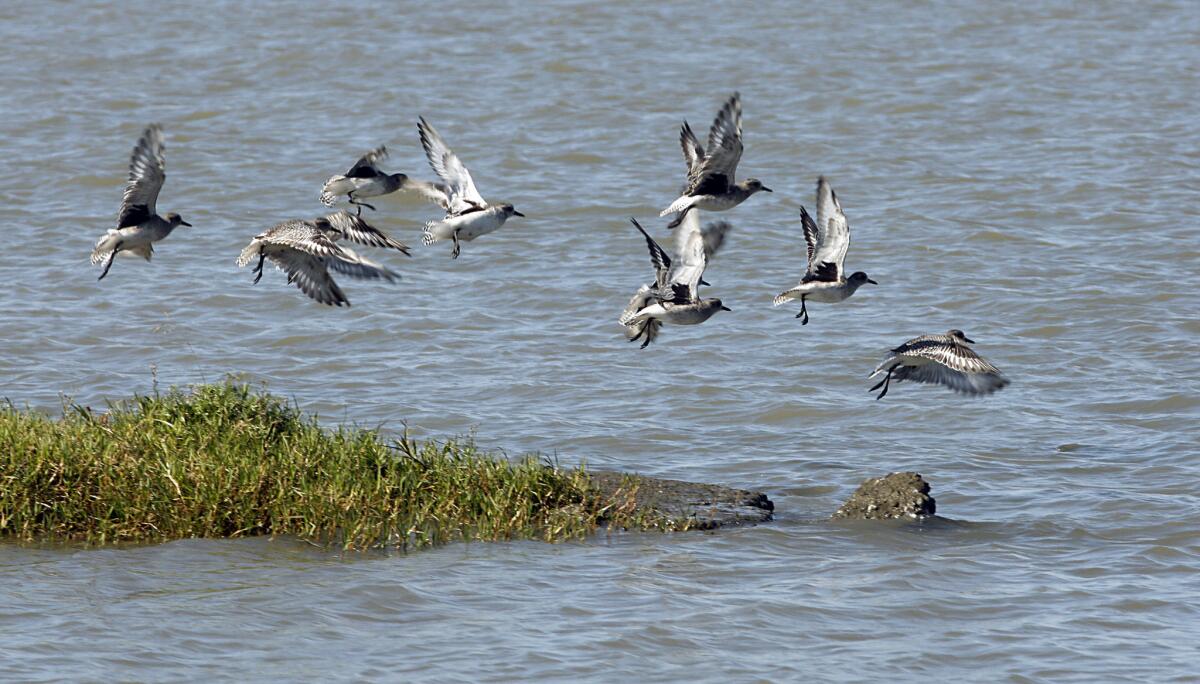Capitol Journal: Brown’s Delta water tunnel plan: A million hours and still not shovel-ready

- Share via
in sacramento — Gov. Jerry Brown says critics of his water tunnel plan who haven’t spent 1 million hours studying it — as his administration has — should just shut up.
Well, that bait is too tempting to resist.
First, only a government could spend that much time on a project and not turn a shovel.
Second, Brown should be thankful so many people have criticized his proposed fix of the Sacramento-San Joaquin River Delta. Because they prodded him into recently improving the project, at least making it less intrusive and ugly.
Here’s what Brown told a Sacramento convention of local water officials last week: “Until you put a million hours into it, shut up!”
The crowd laughed.
Then Brown added, with a slight smirk: “Because you don’t know what the hell you’re talking about.”
A Brown spokesman later said the governor had been kidding. But the body language didn’t show that. It depicted a guy who believes: I’m smarter and know better than anyone.
Maybe he often does. But no one’s thinking is constantly superior.
“The governor has his fingers in his ears and will not listen,” said Barbara Barrigan-Parrilla, executive director of the anti-tunnels coalition Restore the Delta.
Admittedly, I haven’t spent 1 million hours studying Brown’s plan. That’s 114 years, 24-7.
But, guaranteed, I’ve spent a lot more time than Brown in the delta, on and off the 1,000 miles of navigable, winding waterways.
It’s one of California’s best-kept secrets, bucolic, mysterious and serene. The delta is a boating paradise, a winter home for migrating waterfowl and passageway for spawning salmon — the largest estuary on the west coast of America, north or south.
It’s also California’s main water hub, supplying drinking water for 24 million people and irrigation for 3 million acres. But the plumbing is old and broken and needs to be redesigned.
The worst culprits are giant pumps in the southern delta that chomp up fish, including the tiny vanishing smelt. They also reverse San Joaquin River flows, fatally confusing young salmon headed to sea.
That has led to court cutbacks on water pumped south through federal and state aqueducts, angering San Joaquin Valley farmers. This was happening even before the drought really tightened the spigot.
Brown’s solution for making the plumbing more reliable is to bore two 40-foot-wide, 30-mile-long tunnels under the delta to carry fresh Sacramento River water directly to southbound aqueducts. Actually, it would be a 39-mile-long project counting three huge intake pipes siphoning off the river water just south of Sacramento.
But that would reduce fresh water flowing through the delta, making the estuary more salty and some farming problematic.
And the tunnels would be bored through the delta’s most pristine area, a backwater region of meandering sloughs, cottonwoods, salmon and bass, frequented by boaters piloting everything from fishing skiffs to luxury houseboats.
So you don’t have to spend 1 million hours of study to criticize this project, which would muck up picturesque and highly productive pear orchards during the decade-long construction and cost roughly $17 billion, paid for through higher water rates in Los Angeles and elsewhere.
It was going to cost around $25 billion. But Brown cut the price tag by backing off his promise to restore 100,000 acres of wildlife habitat over the next four decades.
That idea was a fantasy anyway. Delta farmers opposed it. There wasn’t any money. And the real purpose was to entice federal fishery agencies to grant the tunnel project a 50-year permit to pump away unimpeded. The feds nixed it.
So now Brown intends to do something more realistic: Restore 30,000 acres — practically all of it owned by government — at a $300-million cost during the remaining 3 1/2 years of his final term.
“People are saying, ‘Gee, you didn’t do the whole 100,000,’” Brown told reporters. “Hey, it’s been zero for a long time and the needs are getting greater, the fish are being depleted. So we’re doing a hell of a lot.”
Yes, if the restoration actually gets done. A major goal is to greatly improve salmon habitat.
One significant improvement in the revised tunnels project is to make it less unsightly and industrial-looking. The new plan eliminates three warehouse-size pumping plants on the Sacramento River. The water will flow to the tunnels by gravity instead.
Because there’ll be no pumping, the project won’t need giant power lines. They’re scratched.
A popular sanctuary for sandhill cranes won’t be treated as harshly.
Under the new permitting setup, federal wildlife officials can readjust the project’s operation as conditions change. No one is sure what global warming will bring.
Many opponents believe that the tunnel project should have been moved closer to the San Joaquin-Sacramento river confluence. There, the tunnels and the cost would have been half the size. Innovative fish screens could have spared the salmon and smelt. And more fresh water could have flowed through the delta before being pumped south. That should have been seriously explored.
But water agencies in the San Joaquin Valley and Southern California — which will foot most of the bill — savored the fresh Sacramento River water.
“It’s not a water grab,” says state water director Mark Cowin, answering critics. “It’s a retrofit using modern technology.”
“It’s still a water grab,” insists Barrigan-Parrilla. “People don’t want this project. We will litigate every step of the way.”
Suggestion to Brown: Don’t tell some judge to shut up.
Twitter: @LATimesSkelton
More to Read
Sign up for Essential California
The most important California stories and recommendations in your inbox every morning.
You may occasionally receive promotional content from the Los Angeles Times.











